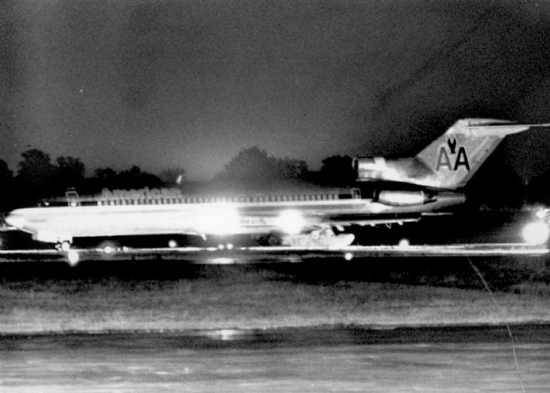
16 Jul BOARDING: ST. LOUIS TO TULSA THE UNBELIEVABLY TRUE STORY OF AMERICAN AIRLINES FLIGHT 119
BOARDING: ST. LOUIS TO TULSA
THE UNBELIEVABLY TRUE STORY OF AMERICAN AIRLINES FLIGHT 119
In November of 1971 a man calling himself D.B. Cooper hijacked a Northwest Ailines Boeing 727, and after collecting a $200,00.00 ransom, parachuted from the aircraft never to be heard from again. Cooper’s act set off a series of copycat hijackers in the following years, but one of the strangest such incidents occurred in 1972.
By June, 23,1972, seven other hijackings had occurred since Cooper’s ’71 disappearance. On that date a man by the name of Robert Wilson paid cash for a ticket to board American Airlines flight 119, taking off from St. Louis, Missouri arriving in Tulsa, Oklahoma. Wilson wore the purple tinted sun glasses of a jazz musician, and boarded the plane with his trombone case. He slouched down in the back row of the plane, appearing to be no different than a typical weary traveler off to his next destination. The Boeing gained clearance from the tower, taxied to its take off position and climbed into the skies over Missouri without difficulty. As the plane began to level out into its cruising altitude, the non-descript musician in the back of the plane called flight attendant Janet Furlong over to him.
Passenger Wilson had opened the trombone case he had carried on board and showed the flight attendant the .45 caliber sub-machine gun he had placed inside of it. At the direction of the jazz musician, now turned hijacker the attendant went to the cockpit opened the doors and told the piolits, “You’re not gonna believe this, but we’re being hijacked.” Passenger Robert Wilson instructed the pilots to change course back to St. Louis, he then changed his mind and instructed them to fly to Dallas, he then changed his mind once more and told them to fly back to St. Louis. While trying to decide which airport he wanted to return to, Wilson was also telling authorities on the ground his demands.
He demanded $502,500.00 in cash (he decided to ask for a non-even amount of cash, because of failed hijacker Garrett Trapnell’s influence, another Cooper copycat), five parachutes, and instructions on how to use it. He ordered the pilots to continuing flying over Missouri and Oklahoma, while authorities on the ground counted his cash. Seeing their opportunity two FBI agents decided they would pose as airline officials and board the plane with the cash, parachutes, and instruct the gunman how to use them.
The 727 touched down at Lambert field in St. Louis where haggling for hostages began. After some negotiation, the mysterious Wilson released all but one of the 92 passengers and allowed the two “airline officials” on board. The FBI agents counted the money, and handed over the parachutes, instructing Wilson how they worked, but even with all their stalling were unable to make any advances on the hijacker. Wilson kept the .45 caliber sub-machine gun trqined on the attendant the whole time. The agents were not discouraged, they believed if they remained patient their opportunity would come, they notified the tower that the hijacker was satisfied and the plane began to taxi for take-off. No one could have predicted what would happen next.
As the 727 circled the skies between St. Louis and Tulsa, news agencies were reporting the hijacking. When Flight 119 landed in St. Louis a crowd awaited them as curious onlookers had gathered, hoping to see the dramatic event unfold.
David J. Hanley of Florissant, a St. Louis suburb, was watching the news live over the TV in the Airport Marriot lounge. Hanley was growing angrier and angrier as he watched along with the rest of the viewing audience, and he decided he was going to do something about it. Hanley turned to a friend that was there in the lounge with him and said, “turn on the radio in a few minutes and you’ll hear something that will rock the world”, with that he left the Airport Marriot and got into his 1972 Cadillac.
Meanwhile, back on the runway, Flight 119 began to taxi for takeoff, got clearance from the tower and began to turn for take-off. At the other end of the runway, David Hanley crashed his ’72 Cadillac (a recent Mother’s Day present to his wife) through the locked security gate, turned his vehicle head on with the oncoming 727 and gunned the engine. The Cadillac reached speeds of 90 MPH as it sped down the runway and caromed off the plane’s nose gear and into its landing gear. The car was demolished, and Hanley was critically injured in the crash.
Not to be deterred by such a heroic act of stupidity, the hijacker transferred to a new aircraft and with pilots, crew, and one passenger as hostages, instructed the pilot to head for Toronto and then to head for John F. Kennedy Airport in New York City.
At 2:50 A.M. the mysterious Wilson, gave the flight attendants each a generous tip, and jumped out somewhere over central Indiana at 8,000 feet.
Parachuting out of a commercial airliner at 8,000 feet is not for amateurs, and the hijacker learned that lesson the hard way. In the air, he became separated from his money and machine gun. The money was found by farmer Lowell Elliott. “I thought it was a groundhog in the field,” Elliott said. “It didn’t move so I took a closer look.” Meanwhile, the gun was found five miles away by another farmer, Ronald Miller, who at first thought the commando-type weapon was a toy when it was turned up by the blades of a liquid fertilizer distributor.
Robert Wilson was not found, however a fingerprint led authorities to their man, a bruised but alive former Navy sailor named Martin J. McNally, 28, of suburban Detroit. “Wilson” had $13 in his pocket.
Hanley, couldn’t remember a thing about his deed. He announced his candidacy for president in 1976.
McNally drew two life sentences and was sent to the federal prison at Marion, Ill., where he met fellow air pirate Garrett B. Trapnell. On May 24, 1978, Trapnell’s girlfriend, Barbara Oswald of Richmond Heights, commandeered a helicopter and ordered its pilot, Allen Barklage, to fly to Marion, where Trapnell, McNally and a third inmate were hiding in a yard.
Barklage grabbed Oswald’s pistol and killed her in flight. The inmates were nabbed.
Trapnell died in prison in 1993. Barklage died in a helicopter crash in 1998. McNally was paroled from a California prison Jan. 27, 2010, at age 67






No Comments